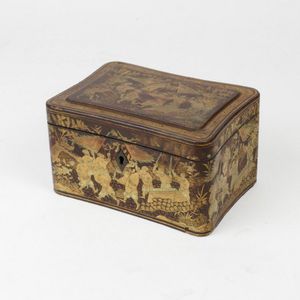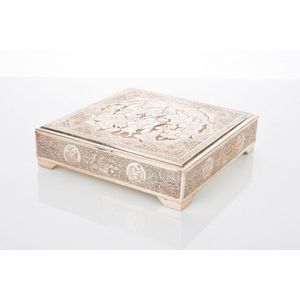Regency Rosewood Inlaid Writing Box with Leather Slope
You must be a subscriber, and be logged in to view price and dealer details.
Subscribe Now to view actual auction price for this item
When you subscribe, you have the option of setting the currency in which to display prices to $Au, $US, $NZ or Stg.
- Rosewood - A dense timber that varies in shade to very light brown to almost black. When rosewood is cut and sanded the colour of the timber will turn black, and after polishing and exposure to daylight, the surface will gradually lighten over time to light brown with black streaks.
The name comes from the odour emanating from the timber when it is planed, sanded or cut.
Rosewood was very popular for use in Victorian furniture in the second half of the 19th century, and at that time most of the rosewood was imported from Brazil. However it also grows in India and Indonesia.
It is used in the sold for chairs and table legs, but for carcase furniture such as side cabinets and bookcases, and for table tops it is always used as a veneer. - Mother-Of-Pearl - Mother-of-pearl, technical name "nacre", is the inner layer of a sea shell. The iridescent colours and strength of this material were widely used in the nineteenth century as an inlay in jewellery, furniture, (especially papier mache furniture) and musical instruments.
In the early 1900s it was used to make pearl buttons. Mother-of-pearl is a soft material that is easily cut or engraved.
Nowadays it is a by-product of the oyster, freshwater pearl mussel and abalone industries. - Regency Period - The Regency period in English furniture design refers to the period when King George III, was declared unfit to rule in 1811, and his son ruled as proxy as Prince Regent, until 1820, and then, after the death of his father as George IV until his death in 1830. The Regency period was preceded by the Georgian period (George I, George II, and George III: 1714 - 1811), and was followed by the William IV period, which only lasted until 1837 when William IV died as was succeeded by Queen Victoria.
This item has been included into following indexes:
Visually similar items

A Victorian chinoiserie tea caddy, the interior with tin liner, the lid decorated with conforming chinoiserie designs, ivory button, width 16.5 cm, depth 11.5 cm, height 9.5 cm.

Wang Hing miniature box, Chinese export silver chased with cherry blossoms, approx 6 cm x 4 cm, circa 1900

Iranian silver cigar box, c. 1970, of square shape, the lid with shaped central panel embossed with Persian figures feasting, the sides decorated with flowers and animals, raised on four feet, hallmarked, approx. Weight 1404 grams height 6 cm width 22.2 cm

A Dutch silver box, the lid embossed with Rembrandt's 'The Night Watch', the sides with tavern scenes, interior wood lined, assay mark for Amsterdam, 11 cm x 8.5 cm x 4.5 cm.
